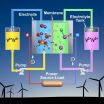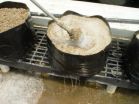(Press-News.org) Researchers have shown for the first time that stem cells injected into enlarged hearts reduced heart size, reduced scar tissue and improved function to injured heart areas, according to a small trial published in Circulation Research: Journal of the American Heart Association.
Researchers said that while this research is in the early stages, the findings are promising for the more than five million Americans who have enlarged hearts due to damage sustained from heart attacks. These patients can suffer premature death, have major disability and experience frequent hospitalizations. Options for treatment are limited to lifelong medications and major medical interventions, such as heart transplantation, according to Joshua M. Hare, M.D., the study's senior author and professor of medicine and director of the Interdisciplinary Stem Cell Institute, University of Miami Miller School of Medicine, University of Miami in Miami, Fla.
Using catheters, researchers injected stem cells derived from the patient's own bone marrow into the hearts of eight men (average age 57) with chronically enlarged, low-functioning hearts.
"The injections first improved function in the damaged area of the heart and then led to a reduction in the size of the heart. This was associated with a reduction in scar size. The effects lasted for a year after the injections, which was the full duration of the study," Hare said.
Specifically, researchers found:
Heart size decreased an average of 15 percent to 20 percent, which is about three times what is possible with current medical therapies.
Scar tissue decreased by an average of 18.3 percent.
And there was dramatic improvement in the function, or contraction, of specific heart areas that were damaged.
"This therapy improved even old cardiac injuries," Hare said. "Some of the patients had damage to their hearts from heart attacks as long as 11 years before treatment."
The researchers had used two different types of bone marrow stem cells in their study — mononuclear or mesenchymal stem cells. The study lacked the power to determine if one type of cell works better than the other. All patients in the study benefited from the therapy and tolerated the injections with no serious adverse events.
Hare's study assessed the effect of stem cell injections differently from other studies of post-heart attack stem cell treatment. His team measured contractility, scar size and structural changes of the heart.
"Studies of bone marrow cell therapy for ischemic heart disease in animals have shown improved ejection fraction (the amount of blood the heart can pump). However, this measurement has not reliably translated to early phase studies in humans," Hare said. "Ejection fraction may not be the best way to measure the success of stem cell therapy in the human heart."
Hare also said their findings suggest that patients' quality of life could improve as the result of this therapy because the heart is a more normal size and is better functioning. "But, we have yet to prove this clinical benefit – this is an experimental therapy in phase one studies. These findings support further clinical trials and give us hope that we can help people with enlarged hearts."
INFORMATION:
Co-authors are Adam R. Williams, M.D.; Barry Trachtenberg, M.D.; Darcy L. Velazquez, R.N., B.S.N.; Ian McNiece, Ph.D.; Peter Altman, Ph.D.; Didier Rouy, M.D., Ph.D.; Adam M. Mendizabal, M.S.; Pradip M. Pattany, Ph.D.; Gustavo A. Lopera, M.D.; Joel Fishman, M.D., Ph.D.; Juan P. Zambrano, M.D. and Alan W. Heldman M.D. Author disclosures are on the manuscript.
The University of Miami Interdisciplinary Stem Cell Institute, BioCardia (makers of the catheter used) and the National Institutes of Health funded the study.
Statements and conclusions of study authors published in American Heart Association scientific journals are solely those of the study authors and do not necessarily reflect the association's policy or position. The association makes no representation or guarantee as to their accuracy or reliability. The association receives funding primarily from individuals; foundations and corporations (including pharmaceutical, device manufacturers and other companies) also make donations and fund specific association programs and events. The association has strict policies to prevent these relationships from influencing the science content. Revenues from pharmaceutical and device corporations are available at www.americanheart.org/corporatefunding.
NR11 – 1043 (CircResearch/Hare)
Additional Resources:
For information about heart attack warning signs, treatment and recovery, visit heart.org/heartattack.
END
RICHLAND, Wash. – Though considered a promising large-scale energy storage device, the vanadium redox battery's use has been limited by its inability to work well in a wide range of temperatures and its high cost. But new research indicates that modifying the battery's electrolyte solution significantly improves its performance. So much so that the upgraded battery could improve the electric grid's reliability and help connect more wind turbines and solar panels to the grid.
In a paper published by the journal Advanced Energy Materials, researchers at the Department of ...
SOUTH AFRICA—The common fig is a subtropical, deciduous fruit tree grown in most Mediterranean-type climates. Although some believe that figs may be the oldest cultivated fruit species on earth, global expansion of fig crops has been hindered by the narrow research base pertaining to production practices and the limited number of fig cultivars currently available. Recently, three black figs were established in the Mediterranean-type climate of Western Cape Province of South Africa to provide fruit for fresh markets throughout South Africa and Europe.
Hein J. Gerber, Willem ...
TOLEDO, OH—In parts of the United States where ornamental and vegetable plants are produced in greenhouses during cold seasons, heating costs are second only to labor costs for greenhouse operators. Greenhouse growers are faced with important management decisions that rely on understanding how temperature settings, heating systems, fuel types, and construction decisions influence their heating costs. To address the lack of user-friendly computer programs currently available for calculating heating costs in greenhouse operations, scientists have created a state-of-the-art ...
BOSSIER CITY, LA—Perlite, a processed volcanic mineral, is widely used as a component of soilless growing mixes. Lightweight, sterile, and easy to use, perlite is popular with greenhouse growers. But because salt and pathogen buildup can occur when perlite is reused, it must be replaced every year or two to minimize the risk of crop failure. The cost of disposing of old material and replacing it with new perlite can be significant and often prohibitive for smaller greenhouse operations. Hanna Y. Hanna, a researcher at Louisiana State University Agricultural Center's Red ...
AMES, IA—Recognizing the need for university students to develop problem-solving skills they will need in their careers, educators are looking to student-centered, problem-based learning strategies. Problem-based learning (PBL) experiences have been shown to promote higher-order thinking skills in students, but, for faculty, implementing and assessing problem-based activities often means a substantial time investment. Iowa State University professor Ann Marie VanDerZanden and graduate student Tigon Woline published a study in HortTechnology that reported on an innovative ...
Systems biology is a holistic approach to the study of how a living organism emerges from the interactions of the individual elements that make up its constituent cells. Embracing a broad range of disciplines, this field of science that is just beginning to come into public prominence holds promise for advances in a number of important areas, including safer, more effective pharmaceuticals, improved environmental remediation, and clean, green, sustainable energy. However, the most profound impact of systems biology, according to one of its foremost practitioners, is that ...
COLLEGE STATION, TX—New research from Texas A&M University and Texas State University found that older adults who participate in gardening may be more likely to eat their veggies. The report, published in HortTechnology, presents the results of an online survey of adults aged 50+ and includes recommendations for promoting gardening "intervention" programs to older adults.
According to researchers Aime Sommerfeld, Amy McFarland, Tina Waliczek, and Jayne Zajicek, studies have shown that poor nutrition is one of several factors responsible for mortality and morbidity in ...
LANE, OK—Corn gluten meal, a powdery byproduct of the wet-milling process of corn, has shown important potential for use as an organic, non-selective preemergence or preplant-incorporated herbicide. A team of researchers from the U.S. Department of Agriculture-Agricultural Research Service and Oklahoma State University recently reported on the impact of corn gluten meal (CGM) applications on direct-seeded squash (Cucurbita pepo), and determined that CGM can be effective and safe if used in banded applications.
Used for years as a supplement in dog, fish, and livestock ...
COLLEGE STATION, TX—Does gardening contribute to quality of life and increased wellness for older adults? Researchers from the Texas A&M and Texas State Universities asked these questions in a survey of people aged 50 and older. The survey revealed some compelling reasons for older adults to get themselves out in the garden.
Aime Sommerfeld, Jayne Zajicek, and Tina Waliczek designed a questionnaire to investigate older adult gardeners' and nongardeners' perceptions of personal life satisfaction and levels of physical activity. According to Sommerfeld, lead author of the ...
New Rochelle, NY, March 17, 2011—A new research tool for studying microRNA expression in zebrafish will help researchers study the effects of miRNA on the early development of this model organism and better understand developmental and disease mechanisms in humans, as described in Zebrafish, a peer-reviewed journal published by Mary Ann Liebert, Inc. The article is available free online ahead of print.
Researchers from University of Oregon (Eugene) have developed a novel, cost-effective method for measuring the expression of microRNAs (miRNA) in specific tissues in ...




